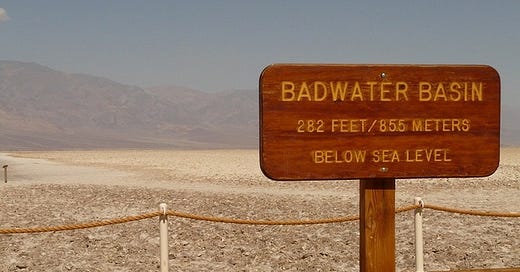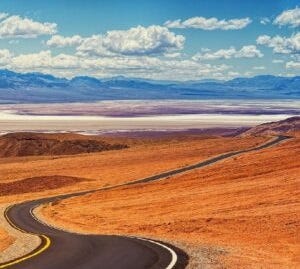BADWATER – MY WORST AND BEST RACE – part 1
The Badwater 135-Mile Endurance Run, “The World’s Toughest Footrace,” is run through Death Valley and halfway up Mt. Whitney in the middle of July. Badwater – my worst and best race.
If you make it. I didn’t. I sat on the porch of my cabin at Panamint Springs, sipping on a beer. I had run only a quarter of the race distance and my race was over. A couple of my crew members had already left for home. The rest of them were in the restaurant up front.
I was upset that my attempt at Badwater had failed. But not overly so. I know that on any given day, things can happen. In the weeks leading up to the start, I knew I was over trained and under recovered. I was tired on the inside.
In recent months I had developed plantar fasciitis that settled in my right heel. It took very little running, or walking, before the familiar dull ache would set in.
Three weeks before, at my last training run, a group of us did eighteen miles from Stovepipe Wells to the summit of Towne Pass. Eighteen miles of uphill. I managed to develop a quarter size blister on the ball of my left foot. It didn’t break the skin and I didn’t give it much thought but for the fact I had never had one in that location. I was happy that my training was done. The next three weeks would be spent resting with some light running just to stay loose.
A few words about blisters. You can count on them. Anywhere the skin touches skin, or shoe, is a likely place. The distance run, and foot moisture, beg blisters. With the extreme heat, we were constantly pouring water over our heads and body. All runners had a pacer to accompany them as a watchdog and inspiration provider. Oftentimes, they would spray the runner down with a mister. The effect of the spray down was brief at best, but worth it as it was just so hot. Still, much of the water ended up keeping the feet in a dampened condition.
The blisters could be ugly, the toenail bed could be so damaged that the nails would fall off as they grew back in the weeks that followed. The interesting thing about them is that with proper dressing, continued running can pound them into a numb state and hardly felt. I think the trick is to care for them quickly and keep moving before they get a chance to set up. Care must be taken that infection doesn’t set in.
That evening, Will, a friend and crew member who had come with me to the training weekend, and I, moved up to Lone Pine, where we would get an early start on summiting Mt. Whitney. It is a 22-mile roundtrip hike. The plan was to be at the top by noon, and headed down by one, because thunderstorms can pop up early afternoon and climbers are exposed to lightning.
MT. WHITNEY
We arrived at the portal well before dawn. It is at 8300’, the end of the road, and the finish line of Badwater. It is also the trailhead to Mt. Whitney, elevation 14,505’. Al Arnold was the first to complete the run from the lowest to the highest points in the contiguous United States. The race used to go to the top before Regulations stepped in.
There was snow in the shadows and it was brisk. It was a marvel how it became even more beautiful as we gained elevation and dawn came upon us, is a marvel. Above Trail Camp at 12,000’, where many stage themselves overnight for the ascent, a number of switchbacks accompany the now steeper climb. The snow was much deeper with increasingly steeper fall offs. To me, it was intimidating. Chains are anchored to the mountain side in many places to assist in climbing.
This continues until reaching The Notch, at 13,000’. At this point the trail slips over to the western side of the mountain with open views up and down the range. From there it is another 1,000’ feet of climb, but on a gradual slope to the top. What surprised me was the western slope of the mountain is nothing like the eastern slope which appears so ragged and peaked from Lone Pine and Highway 395.
A bigger surprise was how hard the elevation hit me. I had no energy. I could take only 20 steps or so before I had to stop and rest. It was the oddest thing. I had never been to that elevation before, but thought I wouldn’t be affected. I was mistaken. Will had been up Whitney a number of times and had no problems at all.
We got to the top about one o’clock, looked around, signed the register, and headed down. There were no thunderclouds building. For that I was grateful. Until we got back down to The Notch, I would have to stop and rest.
THE BLISTER
Then, it was smooth going headed down, but I knew we would be getting back to our motel later than planned. The day’s heat was melting the snow and it was overrunning the trail in many places. I managed to slip crossing one of the overflows, twisting my foot, and tearing the skin of the blister on my foot. It was a stinger. We were close to the trailhead so we continued on.
We scored our dinner, got back to the motel, and I got a look at the blister. Half of the skin on the outer edge was torn. The exposed tissue was meat red. I showered, bandaged the blister, and went to sleep early to get a good start for home the next morning.
I was wakened with a jabbing pain from the blister. It was throbbing. I didn’t want it to get infected. I began thinking I should go get it looked at. I gave it another good hot soak in the tub to see if it would help. And it did. The throbbing stopped.
I was relieved but I knew it would take at least a couple of weeks to heal and build up some cushion. I wouldn’t be doing any final tuning up before the run. I was hoping for a good race day.
For better than two weeks I was walking around with the toes my left foot raised bearing my weight on my heel, and with the heel of my right foot raised, because of the plantar fasciitis, bearing the weight on my toes. I couldn’t help but wonder what this arrangement was doing to my running mechanics. It was both awkward and comical walking around in such manner.
ON TO BADWATER
It was an anxious time as I was putting together the final details of my race and crew. It is common for the entrant to cover the cost of the vans, gas, and motel accommodations.
The blister healed and my heel felt fine. I think the total rest was good for me. I was able to do some light running a few days before we left for the event. I felt good for the race.
In doing Badwater, you must have two crews, each with their own vehicle and supplies, so that one of them can be with you at all times, while the other rests. There is a 60-hour time limit for the race. Some elites will go with a one crew set up, and with their fast times, it is doable.
Both of my most experienced crew members had to bow out, leaving me scrambling to find their replacements. Only two members, of six, had experience.
Another requirement for entry to Badwater is to have crewed for another runner in recent years so that you would have an idea of just what to expect. The runner must also give you a recommendation. I had crewed the previous three years really enjoying it. It does have its challenges. I crewed for Jack Denness, the first runner over 70 to complete the race.
Crew shifts, housing, gas, and water are real concerns. A crew may have to travel some distance for each if the runner cannot keep a planned for pace, or something comes up. It is likely that something will come up.
We had reservations at Stovepipe Wells two nights before the race, then planned for a night at Panamint Springs, then Lone Pine for two nights. With much anxiety and apprehension about my feet and crew, the day finally arrived for heading to Badwater.
My wife, Shinobu, Will, and I, headed for the desert in one of our vans. We met Cousin Ed, and Nancy, in Lone Pine. Lone Pine, near the finish line, also serves as the location for the after-run get together and awards. Leaving their car at the motel we would be staying in upon our return, they loaded into the van for the ride into Death Valley. Tom and Mike, from back East, flew into Las Vegas, picked up our second van, and drove to Stovepipe Wells to meet up with us.
Most of our supplies were purchased before we arrived in Death Valley, but we topped off more water and ice as we made our way. It was a concern that we would run out between the seven of us.
The Worst of It - Part 2, of 3 – Next Week





